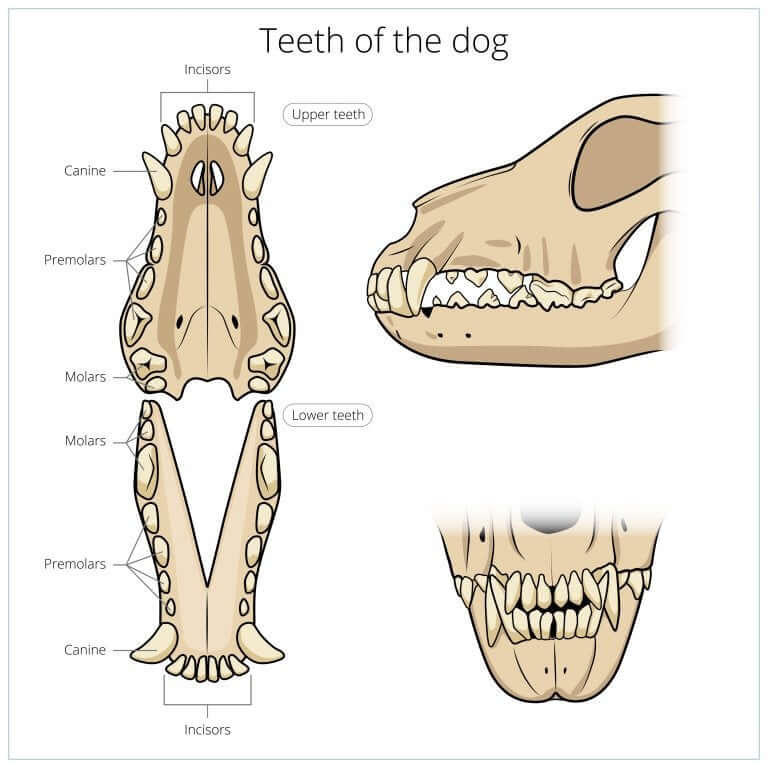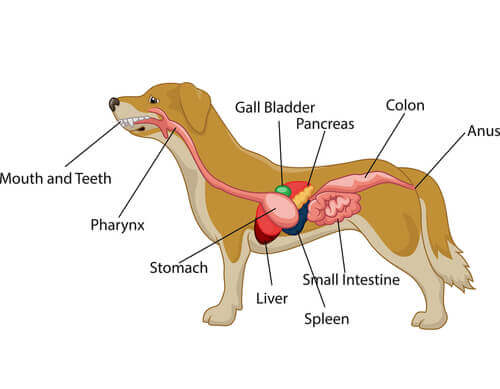A Dog's Digestive System: How Does it Work?

In this day and age, dogs live inside our homes and we should feed them food that’s especially for them. But in many cases, we end up giving them other types of food too. Many of those foods are supposed to be for humans. The question is: can a dog’s digestive system handle that kind of food?
It might seem like dogs can eat just about anything you put in front of their face. The truth, though, is that this can lead to liver and kidney problems that you won’t immediately associate with their diet.
What’s a dog’s digestive system like?
A dog’s digestive system is primarily structured for eating meat. It begins with a digestive “tube” that starts in the mouth which then goes down towards the esophagus, stomach, upper intestine, and lower intestine. Then there are the organs that help process food, like the liver, pancreas, and the gallbladder.
On a macroscopic level, you may not see too many differences from our own digestive system. But there are some important distinctions. For one thing, dogs obviously have different teeth. Their digestive tract isn’t the same length (proportionally) either, especially with regards to the upper intestine.
All adult dogs have the same number and type of teeth – a total of 42. Here they are:
- 12 incisors
- 4 canines
- 16 premolars
- 10 molars

A dog’s jaws
Even with the same number of teeth, their bites can vary. For example, some dogs close their mouths with their teeth in a kind of pincer, which means the incisors will brush against each other. Then there are other dogs that chew with the inner edge of their upper incisors brushes against the outer edge of their lower incisors.
In some cases, the lower jawbone juts out farther than the upper jawbone, also known as prognatism. This is very common in boxers and bulldogs. You also see the opposite version of this with some dogs, where the lower jawbone is farther back than the upper jawbone – this is known as enognatism. This is always seen as a defect.
Going down the digestive tract, the food goes through the esophagus and down into the stomach. The internal walls of this organ have big folds that help to grind up the food once it comes down from the mouth. The food comes down in mostly one piece because dogs don’t chew their food much.
Even further down, in the intestines, there are lots of enzymes that help to chemically digest the food. Some recent studies have found that many breeds of dogs have higher concentrations of enzymes which help them digest carbohydrates better than other breeds. They all have the right enzymes to digest protein.

Dogs also have very short intestines. This is actually typical of carnivores, though certain breeds of dog have longer intestines than others. The intestinal bacteria you find in dogs is also typical of carnivore species.
Are dogs carnivores or omnivores?
If you take a look at the ingredients of any commercial dog food, you’ll see that they have lots of different components. They tend to have everything from meat to different types of grains or beans.
That, combined with the fact that dogs generally eat whatever you put in front of them, may make you think they’re omnivorous, but they’re not. Dogs are more accurately facultative carnivores. This means they should ideally have a meat-only diet, but can survive on an omnivorous diet too.

Basically, it’s in a dog’s nature to be carnivorous. There are a few reasons for that:
- Their intestines are very short, anywhere from 6-15 feet. That difference has a lot to do with breed, and it’s important for you to keep that in mind. The length of the intestines, their permeability towards nutrients, and the bacteria in them can all vary. Omnivorous animals like humans have 16-23 foot-long intestines.
- Dogs have very sharp teeth. Their canines help them to tear food apart and their point molars help them divide it into smaller pieces so that they’ll go down the esophagus more easily.
- The intestinal bacteria of carnivores is very different to that of herbivores and omnivores. The bacteria in their intestines can help them ferment certain nutrients like carbohydrates. Dogs, on the other hand, have a very hard time fermenting carbohydrates.
- Animals’ brains function mainly thanks to the glucose that they get from carbohydrate digestion. So, dogs actually have different metabolic pathways that allow them to produce carbohydrates from proteins.
So, if dogs aren’t omnivorous, how can they digest plant-based foods?
Epigenetics: what role does it play in a dog’s digestive system?
It should be clear at this point that dogs are essentially carnivores. But, in that case, why are they able to digest foods other than meat?
To explain that, you have to understand the concept of epigenetics. This term has to do with the way that our environments may actually influence our genes. A simple example of this idea is how tortoises are born male or female, depending on the temperature of the area they’ve developed in.
Something similar has happened with dogs, but over a much longer period of time. We’re talking about more than 10,000 years. As we have domesticated them, and especially early on, dogs have fed on our “leftovers.”
That has put pressure on their digestive systems that led to changes in the way they synthesize the enzymes they need to digest nutrients. It has helped them to adapt to survive on a more varied diet. This is why, nowadays, they can digest lots of plant-based food sources. It’s also why they’re facultative carnivores.
So, do you feel like you know your dog’s body much better now? We hope we’ve helped you out in that respect, and hopefully you can bring this knowledge to your dog’s diet!
All cited sources were thoroughly reviewed by our team to ensure their quality, reliability, currency, and validity. The bibliography of this article was considered reliable and of academic or scientific accuracy.
- Landecker, H. (2011). Food as exposure: Nutritional epigenetics and the new metabolism. BioSocieties, 6(2), 167-194.
- Marge Chandler. (2018). GUÍA EN FISIOPATOLOGÍA GASTROINTESTINAL DEL PERRO Y EL GATO. Parte 1. Funcionamiento y estructura del sistema gastrointestinal. Affinity Vets.
- Mercer, L. P. (2013). Nutritional Epigenetics. Journal of Nutritional Health & Food Science.
- Weber, M. P., Biourge, V. C., & Nguyen, P. G. (2017). Digestive sensitivity varies according to size of dogs: a review. Journal of animal physiology and animal nutrition, 101(1), 1-9.
